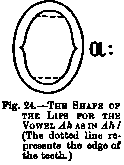Voice Training In Speech And Song - online tutorial
The Structure And Use Of The Vocal Organs, And The Means Of Securing Distinct Articulation.
| Share page | Visit Us On FB |
|
THE VOWEL SOUNDS. 49 |
||
|
63. The Vowel Ah {a;) and its subordinate
 Ah !—Although this sound is described by some writers as being the neutral vowel, it is by no means an easy sound to produce properly. It is true that the lips and tongue are lying practically at rest, and that the lower jaw has fallen by its own weight for the Ah sound in father, but the sound that is produced in hesitating speech (represented by the phonetic sign e) has more claims to be called a neutral sound; it is very similar to the sound A.
For Ah the mouth should be widely opened from above downwards, but not spread outwards as in a smile, for this introduces an Ay or EE quality. The teeth should be an inch apart; place the first finger upon the second finger sideways and insert them between the teeth; place the tip of the tongue in the angle formed between the first finger and the lower teeth. The level of the tongue as a whole must not be raised above the level of the top of the lower teeth ; the tongue must be kept flat in the mouth; a very common fault is the curving of the tongue upwards in the centre or the back. Allow the lower jaw to fall well downwards by its own weight, while the chin is well drawn in; there must not be any stretching of the muscles of the jaw or of the larynx. Separate the lips a little more than the teeth, so that the rims of both the top and bottom teeth are visible; keep the lips close to the teeth without fixing or stretching them. Draw the corners of the lips in towards the middle of the mouth until the sides of v.t. 4
 |
||
|
1 |
||
|
|
||